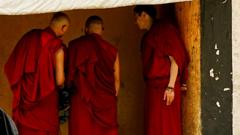The Kirti monastery in the Sichuan province of China remains a pivotal center for Tibetan resistance against Beijing's oppression, where monks navigate constant surveillance while still voicing their struggles. While shrouded in crimson robes and clutching prayer beads, one monk quietly remarks, "Things here are not good for us," as eight unidentified men trail our movements, indicative of the risks involved in even minor expressions of dissent.
The monastery is historically significant, having been the site of protests and self-immolations that symbolize the Tibetan people's fight against Chinese authority. Despite Beijing investing heavily in infrastructure for economic integration and tourism, many Tibetans view these developments as tools for repressing their cultural and religious identity, planted firmly under the watchful eye of the state.
While the Chinese government claims to support religious freedom, Tibetan practices and identities are systematically eroded. The national narrative, led by the Communist Party, labels the Dalai Lama a separatist. The current climate of surveillance, especially surrounding monasteries, creates an atmosphere where discussing even the Dalai Lama's existence can lead to severe consequences.
On the eve of his 90th birthday, followers of the Dalai Lama gather in Dharamshala, India, eager to celebrate, marking a stark contrast to the silence imposed within Tibet. His recent announcement about his succession has sparked mixed emotions among Tibetans, especially when taking into account Beijing's aspirations to appoint a "government-approved" successor.
The landscape leading to Aba reflects the wealth invested by Beijing, though it belies the tightly-controlled narrative surrounding Tibetan culture and identity. The distinction between two worlds is visible—tourists marveling at tradition while Tibetans engage in acts of faith under watchful eyes.
Educators now must enforce stricter regulations that prioritize Chinese language and identity over Tibetan cultural heritage, fueling fears over future generations' connection to their roots. As the Dalai Lama's potential successors loom on the horizon, Beijing's approach to selecting a new leader contrasts sharply with the aspirations of the Tibetan exiled community.
Amidst rising tensions surrounding the Dalai Lama's legacy, the question remains: can a dull version of Tibetan culture, manufactured by the state, truly replace the rich, authentic practices and beliefs that have persisted despite decades of oppression? Tibetans continue to seek to protect their identity, even as they face the perilous path of maintaining their cultural inheritance in the absence of their spiritual leader.




















